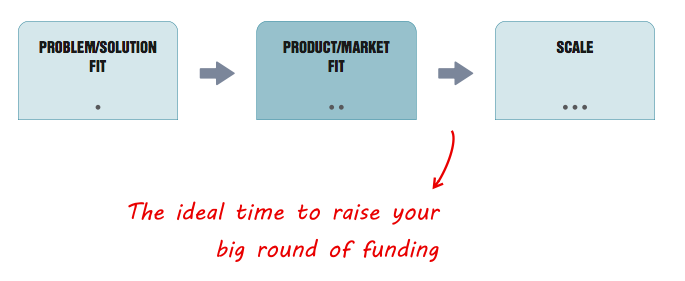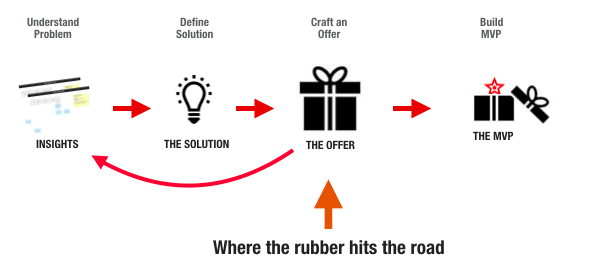While not the same thing, Bootstrapping and Lean Startups are quite complementary. Both cover techniques for building low-burn startups by eliminating waste by maximizing existing resources first before expending effort on acquiring new or external resources.
While bootstrapping provides a strategic roadmap for achieving sustainability through customer funding (i.e., charging customers), lean startups provide a more tactical approach to achieving those goals through validated learning from customers.
But before going any further, I’d like to dispel some common misconceptions about both approaches:
Myth: Lean Startups are cheap startups
This characterization isn’t entirely misguided, but it only captures a sliver of what being lean is all about. Eric Ries co-opted the term “Lean” from “Lean Thinking,” which comes from manufacturing.
Being lean is not about being cheap but being efficient with resources..
Money is just one of those resources, and there is a time to conserve spending (before product/market fit) and a time to spend (after product/market fit). Our scarcest resource, however, is time.
A Lean Startup then optimizes for learning about what’s riskiest in the business model per unit time.
But even at the earlier stages, when we optimize for time, money, and effort, people often associate Lean — especially the minimum viable product (MVP)- with a cheap and fast release 1.0.
An MVP is NOT about being cheap and fast but cheaper and faster than the alternative.
Consider the following MVP from Litmotors:

The alternative was raising millions of dollars in funding, finding partners, and building a road-ready vehicle which, under conservative estimates, would have taken the company two years to pull off.
Instead, the founding team raised a small seed round and built the first MVP by hand in a garage they rented. The MVP took them 12 weeks to complete (the robocop-looking thing in the photo above), which enabled them to secure enough down-payments from early adopters to raise a much larger round and pursue production-ready batches (the finished vehicle in the photo above).
MVP Directive: Race to deliver value.
Myth: Bootstrapped startups never raise money
Most bootstrapped startups start with some form of initial self-funding (sweat equity, credit cards, savings, etc.) and work their way toward sustainability through customer-acquired funding. However, given the type and stage of the business, even bootstrapped companies can and often do choose to raise additional capital if that’s what’s needed for growth.
Right Action, Right Time
I’ve bootstrapped all my companies to date and learned a lot about bootstrapping from Bijoy Goswami, founder of Bootstrap Austin. Bijoy doesn’t limit the definition of bootstrapping to the more commonly held one about building a company without external funding but rather views bootstrapping as a philosophy summarized as “Right Action, Right Time.”
This mantra applies just as well to lean startups as it does to bootstrapping:
At every stage of the startup, there are a set of actions that are “right” for the startup in that they maximize return on time, money, and effort.
A lean/bootstrapped entrepreneur ignores all else.
While bootstrapping and lean startup techniques are not just limited to funding, funding is one of the first problems entrepreneurs tackle. Many (especially first-time) entrepreneurs feel that step 1 is writing a business plan and getting funded. However, during the early stages of a startup, all you have is a vision and a set of untested guesses. Selling this to investors without any level of validation is a form of waste.
Waste is any human activity which absorbs resources but creates no value.
- James Womack
Why Premature Fundraising is Waste
Getting funded is not validation
Seed-stage investors are just as bad at guessing what products will succeed as you are. Without any product validation to rely on, they hedge their bets against your team’s past track record and storytelling ability. So while getting funded at this stage is a testament to your team-building and pitching skills, it isn’t product validation.
Everything gets ten times more expensive
Funding is not charity but a very high-interest loan. You need to return this investment at a 10x rate of return. So that company cell phone that used to cost you $100/mo before funding now costs you $1,000/mo post-funding!
Without validation, you have no leverage
More importantly, without validation, you don’t have product/market credibility, which typically comes at a price — reflected in lower valuations and investor-favored term sheets.
Investors measure progress differently
While validated learning measures progress in a lean startup, most investors measure progress through growth. Reconciling the two during the early stages of a startup (when the hockey stick is largely flat) can be highly challenging and distracting.
Getting funded always takes longer than you think
Time is more valuable than money. Would you rather spend six months pitching investors so you can refine a story based on an untested product or spend time pitching customers so you can tell a credible story based on a tested product?
Early traction is a pre-requisite
Many of the top accelerators want to see you demonstrate some early traction even before considering your application. The average company that enters Y Combinator, for instance, generates $1,000/mo in customer revenue.
Traction speaks louder than words.
Too much money can actually hurt you
Money is an accelerant, not a silver bullet. It lets you do more of what you’re currently doing but not necessarily better. For instance, if you’re building an MVP, more money might tempt you to hire more people and wait to build more features, both of which can hurt you and slow you down.
Constraints drive innovation but, more importantly, force action.
You have to build less, get it out faster, and learn faster with less money.
Startups that succeed are those that manage to iterate enough times before running out of resources. Time between these iterations is fundamental.
- Eric Ries
What about all the advice and connections?
Raising funding is not the only way to get good advice. You can and should start building a diverse board of advisors early — made up of customer, technical, and business advisors. Many are happy just to be asked, others might require a little equity to formalize a relationship.
It is cheaper than ever to start
The good news is that starting a company is easier than ever. You don’t need a lot of capital to start defining, building, and even iterating a minimum viable product toward product market fit.
You don’t need permission to start.
When is the right time to raise funding?
Both Lean Startups and Bootstrapping define three distinct stages of a startup.
While completing stage 1 is the minimum gating criteria for fundraising, stage 3 is the ideal time.
Stage 1: Problem/Solution Fit
This stage aims to find a problem worth solving, i.e., achieve Problem/Solution Fit. The most efficient way of doing this is building an offer and then testing it through customer interviews and/or landing pages. From my work with hundreds of other entrepreneurs (in the BOOTSTART program), I’ve found that this stage usually takes weeks to a couple of months to complete.
Demonstrating problem/solution fit through customer discovery findings and landing page conversions is much more credible than an untested story. The question then becomes can you execute a solution to this problem and get customers to pay you?
Stage 2: Product/Market Fit
This stage aims to build something people want and validate your business model, i.e., achieve Product/Market Fit. This is typically the hardest and most uncertain of the three stages, as you are simultaneously iterating on the product and searching for a repeatable and scalable business model. This stage can take months or years to navigate. Many startups run out of iterations here and either seek external funding or give up.
Having built a minimum viable product and gone through a few iteration cycles certainly puts you in a much stronger position to demonstrate your ability to execute and demonstrate early traction.
You don’t need lots of users to validate a business model at micro-scale — only a few good customers.

Stage 3: Scale
After Product/Market Fit, your objective is to SCALE. This is the only time when both you and investors are aligned on the same measure of progress — growth. Now is the best time to raise funding if you still need it (dependent on your business model goal). If you’ve been charging customers all along, you might find you don’t need a lot of additional capital, which ironically is also the best time to raise it. All the money gets invested towards optimizing your engines of growth which is what investors want to see.
How do I survive Stage 1 and get to early traction?
Keep your day job
The first stage, finding Problem/Solution fit, can be done part-time with very little burn. It typically has a lot of waiting time built in, e.g., contacting customers, scheduling interviews, collecting metrics, etc. Until you find a problem worth solving, quitting your day job doesn’t make sense.
Build an audience
Now is also the best time to build an audience around your problem domain. Start a blog. Comment on other blogs. Get active with social media in other ways.
Build a Mafia Offer before your MVP
Before you can deliver value to customers, your customers have to want your MVP. You test this not by building out your MVP but by testing your promise or offer. My favorite offer type is the Mafia Offer which, as you can guess, is an offer your customers can’t refuse — not because your stronghold them, but because it’s too good to pass up.

The Mafia Offer is built through a combination of problem, solution, and jobs-to-be-done interviews designed to uncover what customers want versus what they say they want. The next step is then assembling your learning into an offer your customers can’t refuse.
“It is not the customer’s job to know what they want.”
- Steve Jobs
If you can’t get customers to accept your mafia offer, why do you think your MVP would be any different?
Conserve burn rate
The biggest burn in a software business is people. Hardware is cheap.
Rent, don’t buy. Don’t scale till you have a scaling problem. Don’t hire till it hurts.
Charge from day one
Testing pricing early and getting paid is the ultimate customer validation in a lean startup which aligns nicely with bootstrapping, where cash flow is king. Make a goal of first covering your hardware/hosting costs, then your people costs.
Sell other related stuff along the way
It is very tempting to take on unrelated consulting to survive, but it becomes difficult (if not outright impossible) to build a great product in parallel. Instead, look for other related stuff you can sell along the way. License out a piece of your technology, write a book, give workshops, get paid to speak, etc.
Shortly after I started building my technology platform in my first company, another entrepreneur contacted me, who essentially needed what I was building for a different use. He funded the platform's development in exchange for a right-to-use license to our platform. Not only was this related work, but it also helped uncover customer and technology validation.
My next company started as a series of blog posts (right here on this blog) which turned into a book, workshops, Lean Canvas, and eventually the Lean Stack platform. Each product was both a learning tool and a product that we sold along the way (and still sell).
The Airbnb founders sold branded cereal while testing their idea to generate both awareness and much-needed cash.
Learning how to make money is a basic entrepreneurial survival skill that they unfortunately still don’t teach at school.
Hold yourself externally accountable
Getting hit by an idea is like falling in love. The first stage is what I often refer to as the honeymoon stage of the idea, when it seems like anything is possible. This is also the stage where we easily lose track of time, and days quickly turn into weeks and months. The best way to maintain progress is by building an external accountability system with other stakeholders to hold yourself regularly accountable.
Ready to Level-up your Idea?
Go From Idea to Early Traction in Less Than 8 Weeks Without Wasting More Time, Money, and Effort.
Start Now


